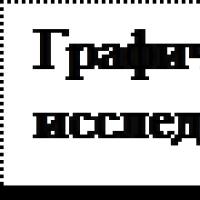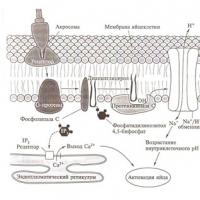Paintless dent remover - auto electrician. Three ways to remove dents without painting your own hands Homemade dent fungi
There are several ways to straighten dents. The traditional option involves straightening, puttying and repainting or replacing the damaged part. However, if the paintwork is intact, the repair can be greatly simplified by using the paintless dent removal equipment discussed below.
Peculiarities
This alignment technology can be used for any metal car body parts. The main condition for leveling dents in this way is the integrity of the metal and paintwork. That is, on the damaged area, the presence of metal breaks, cracks, chips and other paint defects is unacceptable. However, minor damage such as scratches may be present and should be repaired by polishing.
Equipment
Levers and fenders
Such a paintless dent repair tool is used for mechanical alignment from the inside. As a lever, you can use an elongated pin or a flat bar. The technology under consideration is based on differential pressure. The principle of work is to extrude the washed area from the back side with a lever placed in the technological hole. When the material returns to its original place, a click occurs. You need to press gently and smoothly, controlling the appearance of edges and peaks. To straighten them, a fluoroplast chipper is used.
However, since this method is associated with penetration into the car, its scope is limited, since not all parts of the body can be reached with a lever through technological holes.
Pops a Dent
This is a specialized tool kit for fixing paintless dents, including an applicator, glue and a mini lifter. Such a specialized kit is used for external straightening of dents. Its basis is a device in the form of a bracket with two rubber tips. In addition, the set includes glue, a gun, a set of nozzles.
The pre-damaged area of the car is degreased. Then heated glue is applied with a gun to one of the nozzles (also fat-free) and set in a clockwise circular motion in the center of the dent. In this case, excess glue protrudes through the holes in the nozzle. The hardening time is 2 - 3 minutes. After it dries, the dent is pulled out with a mini-lifter - a bracket is installed on the nozzle and it is wound with a lamb until the defect is completely straightened. Upon completion of work, the device is left on the work surface for 5 minutes. At the end of the work, the surface is cleaned of glue.
There are other equipment for removing dents without painting by this method. For example, a piston is used in the same way. It is also glued to the damaged area and the dent is straightened by pulling. May not be used professional tool, such as a set of suction cups. The technology of their application is the same.
The adhesive method has a much wider scope, since with outside almost all dents can be repaired. At the same time, the work is very simple to do with your own hands.
Vacuum suction cups
The technology of using vacuum suction cups differs from the above-mentioned suction cups attached to glue, since this equipment is installed on the working surface by the vacuum method.
The pre-damaged area of the car is cleaned. Then a suction cup is installed and a vacuum is created in it with a pump. Finally, the pump hose is disconnected and the dent is pulled out. Upon completion of the work, they get rid of the vacuum by opening the valve and removing the suction cup. This technology compares favorably with the adhesive method by the absence of the need to clean the body after repair.
Lever set
Such equipment is used when straightening dents using PDR technology. The set includes many hooks that differ in shape, length and bend of the working part. In addition to them, you will need a building hair dryer, a plastic gasket called a punch, and a mallet. It may be necessary to dismantle the inner lining and adjacent parts of the car before starting work. On a pre-cleaned working surface, the stress of the metal is relieved at the bending points. Then the damaged area is heated to 40 - 50°C. The edges of the bend are lightly tapped using a drift to avoid damaging the paintwork. Alignment is carried out by pressing on the damaged surface from the back. For this, a lever is selected depending on the conditions for the location of the defect, it is inserted into the technological hole and, turning the handle, acts on the surface. Professional kits are equipped with polymer wedges that are placed under the hooks to prevent damage to parts. The technology under consideration is the most difficult for do-it-yourself repairs, as it includes various methods repair. It is usually used to correct complex and extensive defects.
Magnet
This tool is used to straighten dents by pulling. Put a rag under it so as not to damage the paintwork. The magnet is moved from the edges to the center of the dent, slightly pulling.
Hairdryer and compressed air can
The use of such a set involves a thermal method for straightening dents. It is based on the desire of the metal to return to its original shape under the influence of temperature. First, the damaged area of the car is heated with a building hair dryer, and then air from a can is directed onto it. In this case, the alignment of the metal occurs. When straightening large dents, this operation will have to be carried out at several points. Moreover, their location is not chosen randomly, but depending on the shape of the defect. So, for round dents, the points are located along the radius, and for oval dents - along the narrow side. If there are rigid elements in the defect zone, the alignment begins with them. This method does not always allow you to completely straighten the damage, therefore, for complete straightening, use a mallet with a rubberized substrate material to protect the paintwork.
Also, among other things, you will need a set of protective equipment in the form of gloves and a mask, since these works are associated with high temperatures (300 - 650 ° C).
There is also an option to perform repairs by this method using household materials. So, as a heating tool is suitable gas-burner and water can be used for cooling.
Set of rubber mallets and anvil
This equipment is used for tapping out dents from the back side, and the anvil is placed outside to avoid bending the metal in the opposite direction. Percussion starts from the center of the dent, moving to the edges in a circular motion. The force of blows should be controlled, since its excess can lead to thinning of the metal. In the absence of access to the damaged area, a set of hooks is used.
No matter how careful and prudent the driver is, he will still not be able to insure against unpleasant situations on the road, including minor damage to the car. Of course, if the hood or fender of the car is soft, there can be no options here - you will have to send the car for repair.
But if the damage doesn't look big, you can try straightening your car yourself without spending time and money on service. For this, there is a unique development of a device for removing dents on a Pops-A-Dent car, which is worth a few words.
Video
Tool Benefits
The Pops-A-Dent Kit, which you can purchase at a reasonable cost, is a kit capable of repairing small dents. Using Popsa Dent, you can not only smooth out faults, but also give the surface of the car its former appearance.
Despite the apparent difficulties, not only a man, but even a woman can handle the device. The only condition required when using the repair kit is special care and slowness.
The clear benefits of the Pops-A-Dent Dent Removal Tool include:
- no scratches during the use of the kit;
- the ability to use Pops-A-Dent for any brand of car;
- ease of use;
- compactness of the device, which allows you to use it in any conditions;
- significant savings in time and money.
With the help of a unique car dent remover, you can fix problems yourself, without damaging the paintwork and without resorting to the help of specialists.

The Popsa Dent set is very reliable in use, and its effectiveness has been proven by numerous tests and customer reviews.
How to use the kit
Working with the tool is not difficult. The gun is filled with glue, then the damaged area is covered with the composition, where the suction cups are mounted.
A bracket with a screw is put on the suction cups - and you begin to gently pull out the dent, giving the surface its original evenness.
Without being in a hurry, any motorist will straighten out bumps quickly enough.
Stages of work:
- Clean and degrease the dent on the car.
- Depending on the size of the damage, choose one of the three nozzles.
- Glue the selected nozzle with glue using a thermal gun.
- Wait 5-10 minutes for the glue to harden.
- Put a bridge-bracket on the nozzle.
- Turning the nut, tighten the dent until it is level.
- Remove the remaining glue from the surface of the car with a special rod.
Equipment
- bracket;
- three suction cups;
- gun for heating the adhesive filler;
- thermal adhesive composition;
- glue removal rod;
- instruction.

The Pops Dent repair kit will save not only time, but also nerves - after all, the car will be repaired by your own hands, and this is worth a lot! This device is a great alternative to expensive body repair work.
Every car repair specialist knows that car body dents are a common problem for their customers. However, not every master has necessary tools for repairing dents without painting.
What tool do we sell
Looking into the catalog of our PDR Center Moscow online store, you will find everything you need to complete the task of removing dents without painting: hooks, lamps, glue tools and much more.
In chapter "Tool Sets" you will find ready-made kits that will help you quickly and efficiently cope with dents and surface irregularities. The main difference between these sets is the number of hooks, the size of the lamps and the presence of a minilifter.
Lighting equipment- no less important purchase than the hooks themselves, because only having good lamp, diffuser and dimmer, you can quickly fix dents on the body in such a way that no one will ever notice it.
By visiting the section " Accessories”, you can buy the necessary tools for reining in, various suspensions, fastenings. All this will become indispensable helpers in straightening complex dents.
Of course, the main assistants in the difficult task of pulling out irregularities are hooks and nozzles. You can buy hooks of different diameters separately or immediately take a set that is suitable for all occasions. Interchangeable handles and attachments will also serve the advanced crafter well.
Concerning adhesive system, in the catalog you can find all kinds of minilifters, glue guns, reverse hammers, as well as fungi from different manufacturers.
Do not forget about additional equipment, which can greatly facilitate the work of the wizard. These are various thickness gauges, pneumatic devices, polishing wheels of different hardness (detailing) and other quick lifting systems.
In this video you will learn how our store and training center works:
Prices for PDR tool
In total, we work with more than 30 suppliers, which allows us to keep a wide range and low prices.
In capable hands
Having bought the necessary professional tool, you still need to learn how to use it correctly. And our masters will help you in this difficult task. In the training center of the company they will tell you how to use this or that equipment correctly in order to return the car to its former shape, they will teach you how to put into practice each of the devices, and raise your professional level. PDR Center Moscow is your reliable partner and friend.
Removing dents on a car body is one of the most popular straightening operations. The most experienced motorist can get a slight deformation of the metal case for reasons beyond his control, so people often encounter such problems, and no one is immune from them. It’s also expensive to turn to specialists every time because of such trifles - it’s much easier to have a tool on hand that would help you correct the body geometry every time on your own. Just for such tasks, kits are offered that allow a non-destructive method to make repairs. It is a paintless dent removal tool that also saves the user the trouble of refinishing the paintwork.
General principles of the tool
The main feature of this tool is the ability to provide mechanical impact, while destroying the coating of the body. In other words, hammers, sledgehammers and other tools that have a percussive effect are excluded. This condition limits the scope of the wizards, but this did not prevent us from identifying fully working types of tools for removing dents without painting, which are available to the average user.
First of all, these are vacuum suction cups, which differ in the way they are gripped and in their structural configuration. The category of hook-shaped devices, which also have their own characteristics of action, is also popular. At the same time, both groups are combined with the most gentle effect on the paintwork of the body, which minimizes repair costs. Another thing is that non-destructive repair methods also have their drawbacks.
Dent suction cups

The device consists of a rubber or plastic suction cup, which provides a hitch to the target area, supporting elements and working bodies. Mechanical restoration is provided by a metal structure - most often it is a system of screw connections included in a durable holder. By tightening the screws, the user attracts the previously captured area, thus correcting the defect.
What is good vacuum tool for removing dents without painting? First of all, a sufficiently high force of action, sufficient to deform the body metal of most passenger cars. Another thing is that dimensions are very important in choosing a vacuum suction cup. This applies to both the diameter and the number of suction cups in one design. There may be 1, 2 or 3. The choice depends on the size and depth of the dent. In the process of work, you must first mark the deformed zone with the designation of the deepest depressions. Further, the sucker with supporting segments is positioned so that the action falls on that very deep point. It will pull out first. Although with small dents, experts recommend starting work not from the center, but from the edges - this will provide a more even geometry at the exit.
Adhesive and magnetic gripping methods

Capturing can be done through an adhesive suction cup or a magnetic block. Both principles allow you to cope with different dents, if the design has been chosen correctly. So, the adhesive tool for removing dents without painting differs not only in its screw design, but also in the area of the sticking - accordingly, the larger it is, the stronger the recovery force of the metal surface will be.
Less common. If in the first case it is enough to apply glue to the suction cup and continue the reverse deformation, then in the case of magnetic devices, it is required to introduce an appropriate block into the design. Usually, according to this principle, a home-made tool for removing dents without painting is designed, which also has levers for mechanical correction of the body, focusing on the “legs” of the structure. The latter give emphasis to the initially smooth surface. The magnet block itself is wrapped in a strong and thin fabric so that the edges do not scratch the paint layer.
Dent hooks

A fairly simple method, but it requires several conditions to be met. Firstly, the possibility of internal dismantling should be provided, which happens infrequently, therefore the vacuum method is more common. Secondly, even if there is access to the target area from the inside, the problem area should have an emphasis on a reinforcing structure - a stiffening shelf, a box or a stamping.
There is a hook-shaped paintless dent remover designed to work with cavities, there are door models in the form of flat springs, as well as flags used on the rear arches. In each case, the user is required to place a lever between the skin and the support piece, and then turn the handle so that there is a corresponding kickback on the area of the dent. The success of the operation will also be determined by how correctly the design of the hook and its dimensions were chosen.
Accessories and fixtures

Initially, you should consider means of lighting problem areas and auto chemicals. As far as lighting is concerned, the best option to work from the inside there will be a small LED lamp on the battery - it will need to be suspended and directed to the hook installation point.
As for vacuum suction cups, such a set of tools for removing dents without painting should already contain an adhesive composition for treating the target area as standard. However, the user must take care of the cleaning agent, which will be needed after the completion of the straightening of the body. A special polishing compound will allow you to hide small defects, clean up small distortions from the suction cup, and in some cases restore the original color.

Much of the effectiveness of using a non-destructive tool for repairing dents is determined by the skill of the master himself. Experienced installers do not advise using excessive force even when working with deep and large defects. The power of the impact, as a rule, is sufficient to correct the defect. The main attention should be given to the accuracy with which dents are removed without painting. The tool should be convenient and comfortable - this will make it possible to more accurately perform manipulations. For comfort, it is also recommended to use nozzles, extensions and adapters that allow you to optimize physical effort, more accurately calibrating it.
What do new technologies offer?
One of the most advanced solutions in this group of instruments is the magneto-inductive apparatus. It acts on the problem area through eddy currents. Contact with metal surfaces provokes inductive excitation, which makes it possible to heat the area and correct its geometry pointwise.
It is also possible to independently inductively remove dents without painting. It is advisable to use a do-it-yourself tool in a garage or other room where fire protection equipment is provided. Such devices do not harm the environment, but in the wrong hands they can be dangerous due to the risks of electric shock and fire.

Conclusion
The problem with using a non-destructive straightening tool is that each body damage is individual. Therefore, it is almost useless to purchase one universal paintless dent removal tool that could help in all cases. Experienced craftsmen advise purchasing sets of such devices that could cover a wide range of possible defects - from small hail to deep ones, which also affect the internal structure. At a minimum, vacuum suction cups and hook-shaped straighteners should be ready - as for induction devices, their use justifies itself if regular dent repair is needed.
All three methods are quite simple, they can be done by hand, as they do not require expensive equipment and special skills. Removal of dents without painting is carried out by vacuum, glue and PDR technology.
To begin with, it is necessary to inspect the damage. Paintless dent repair cannot be carried out if:
- damaged paintwork;
- the deformation has a complex shape with deep, sharp fractures;
- the deformed area was already painted, and the painting was done poorly;
- the car has been in operation for more than 15 years and microcracks and traces of corrosion are visible on the paintwork.
In all other cases, you can straighten the dents with your own hands.
Pulling out dents is done using a special Pops-a-Dent kit.

It includes a special plastic rocker. It has wide legs with soft polymer sponge at the ends to prevent damage to the surface. Several nozzles of various sizes, it is their soles that are glued to the defect and straighten the dents. Hot-melt gun and a few sticks with silicone hot-melt adhesive.
- Using this device, removing a dent with your own hands is quite simple: We degrease the defect and wipe it dry. There should be no dust on the surface.
- We quickly apply the melted glue to a clean nozzle and press it against the deformed surface, as if twisting it left and right a quarter of a turn.
ATTENTION! The glue must necessarily come out through the technological holes in the sole of the nozzle, this will give the mount additional strength.
- Cooling time 2-3 minutes.
- We pass the stalk of the nozzle into the hole.
- We wind the lamb onto the thread and begin the slow straightening of the dent to the level of the surrounding metal of the body.
- Leave for 5-7 minutes in this position.
- We unscrew the lamb and remove the arc.
- We heat the plastic with a building hair dryer at the lowest temperature.
- We separate the nozzle by slightly scrolling it to the right, to the left.
However, if you drive carefully and dents are atypical damage for your car, buying the whole set is completely unnecessary. It is enough to purchase a glue gun, which can be useful on the farm. The arc can be easily made with your own hands from wood, and as a nozzle, use a regular screw with a wide hat. Pulling dents will happen a little differently:
- glue is applied directly to the defect;
- a bolt head is applied to the molten mass;
- wait a minute, one and a half, so that the plastic grabs slightly;
- a new layer is applied over the cap and the old glue so that the layers stick together.

The further process of removing dents on the car will occur in the same way as described earlier.
Vacuum
Removing dents without painting by the vacuum method is similar in process to the adhesive technology. However, it has one indisputable advantage over it. After the repair is completed, there is no need to remove the adhesive, risking damage to the paintwork or re-deforming the surface.
Removing a medium-sized dent on a car is done using a vacuum suction cup. Different models have different sole areas. The ideal option a case is considered when the sole of the suction cup is slightly missing from the border of the defect.

The preparatory process is limited only to cleaning the work surface. Vacuum is created in the installed suction cup using an electric or manual pump. Once a tight and secure fit is achieved, the hose is disconnected and the dent repair can begin.
After the surface has taken its original form, a special valve opens and the suction cup is easily removed from the car body.
PDR Technology
This process is the most difficult to do by hand. It will require a set of rather expensive, special tools - levers.

This paintless dent repair is used for extensive and complex damage. The process consists in acting on a dent on a car from the inside of the surface of the body. If necessary, the inner lining is removed and the parts that interfere with access are dismantled.
The hooks used to remove dents from a car come in a variety of shapes and lengths. Their working parts, which directly affect the metal, are bent at different angles.
- Before fixing a dent, work surface cleanse.
- In places of bending, damage relieves the stress of the metal.
- The part is heated with a building hair dryer to 40-50°C.
- The edges of the bend are slightly tapped through a plastic gasket (punch).
- Alignment of dents is carried out by pressing on the metal surface from the inside.
The lever of the most appropriate shape is inserted into the technological hole, scrolling the handle, and with a pressing movement act on the surface. Straightening dents with hooks requires certain skills and accuracy. In professional kits, there are special wedges made of polymers that are placed under the metal of the hook so as not to deform the elements of the car.
See also video
 Venice region. Veneto. Italy. Excursion into history
Venice region. Veneto. Italy. Excursion into history What is included in housing and communal services
What is included in housing and communal services Test for volitional qualities of a personality Tests for the formation of moral volitional qualities
Test for volitional qualities of a personality Tests for the formation of moral volitional qualities New Era: Saturn in Capricorn (2018–2020) - Forecast by Zodiac Signs
New Era: Saturn in Capricorn (2018–2020) - Forecast by Zodiac Signs Embryonic histogenesis
Embryonic histogenesis Exercise and other ways
Exercise and other ways Wooden ladder: do it yourself from a bar
Wooden ladder: do it yourself from a bar